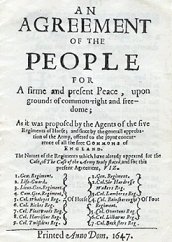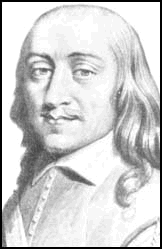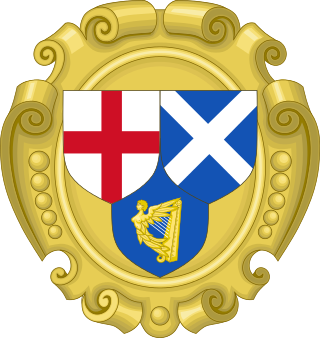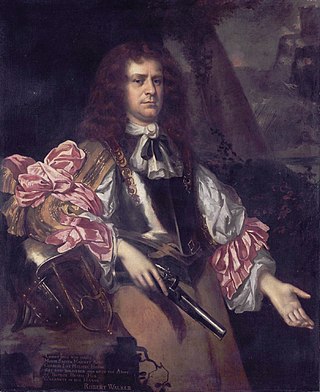
Oliver Cromwell was an English statesman, politician, and soldier, widely regarded as one of the most important figures in the history of the British Isles. He came to prominence during the 1639 to 1653 Wars of the Three Kingdoms, initially as a senior commander in the Parliamentarian army and latterly as a politician. A leading advocate of the execution of Charles I in January 1649, which led to the establishment of The Protectorate, he ruled as Lord Protector from December 1653 until his death in September 1658. Cromwell remains a controversial figure due to his use of the army to acquire political power, and the brutality of his 1649 campaign in Ireland.

The Levellers were a political movement active during the Wars of the Three Kingdoms who were committed to popular sovereignty, extended suffrage, equality before the law and religious tolerance. The hallmark of Leveller thought was its populism, as shown by its emphasis on equal natural rights, and their practice of reaching the public through pamphlets, petitions and vocal appeals to the crowd.

The New Model Army or New Modelled Army was a standing army formed in 1645 by the Parliamentarians during the First English Civil War, then disbanded after the Stuart Restoration in 1660. It differed from other armies employed in the 1639 to 1653 Wars of the Three Kingdoms in that members were liable for service anywhere in the country, rather than being limited to a single area or garrison. To establish a professional officer corps, the army's leaders were prohibited from having seats in either the House of Lords or House of Commons. This was to encourage their separation from the political or religious factions among the Parliamentarians.

Henry Ireton was an English general in the Parliamentarian army during the Wars of the Three Kingdoms, and the son-in-law of Oliver Cromwell. He died of disease outside Limerick in November 1651.

Sir John Wildman was an English politician and soldier.

Colonel Edward Sexby was an English Puritan soldier and Leveller in the army of Oliver Cromwell. Later he turned against Cromwell and plotted his assassination, which Sexby considered tyrannicide, as a decapitation strike, which would then be followed by a joint regime change uprising by both Cavaliers and Levellers. Failing in his efforts, Sexby was taken prisoner and died in the Tower of London.
This is a timeline of events leading up to, culminating in, and resulting from the English Civil Wars.

The Putney Debates, which took place from 28 October to 8 November 1647, were a series of discussions over the political settlement that should follow Parliament's victory over Charles I in the First English Civil War. The main participants were senior officers of the New Model Army who favoured retaining Charles within the framework of a constitutional monarchy, and radicals such as the Levellers who sought more sweeping changes, including one man, one vote and freedom of conscience, particularly in religion.
The Corkbush Field Mutiny occurred on 15 November 1647, during the early stages of the Second English Civil War at the Corkbush Field rendezvous, when soldiers were ordered to sign a declaration of loyalty to Thomas Fairfax, the commander-in-chief of the New Model Army (NMA), and the Army Council. When some refused to do this they were arrested, and one of the ringleaders, Private Richard Arnold, was executed.

Robert Lilburne (1613–1665) was an English Parliamentarian soldier, the older brother of John Lilburne, the well known Leveller. Unlike his brother, who severed his relationship with Oliver Cromwell, Robert Lilburne remained in the army. He is also classed as a regicide for having been a signatory to the death warrant of King Charles I in 1649. He was forty-seventh of the fifty nine Commissioners.
The Army Council was a body established in 1647 to represent the views of all levels of the New Model Army. It originally consisted of senior commanders, like Sir Thomas Fairfax, and representatives elected by their regiments, known as Agitators.

Thomas Rainsborough, or Rainborowe, 6 July 1610 to 29 October 1648, was an English religious and political radical who served in the Parliamentarian navy and New Model Army during the Wars of the Three Kingdoms. One of the few contemporaries whose personal charisma and popularity rivalled that of Oliver Cromwell, he has also been described as "a soldier of impressive professional competence and peerless courage".
Thomas Rawton was one of the highest-ranking officers to support the Levellers, and served with Parliament on both land and sea. He was the eldest son of Captain John Rawton, a naval officer who made his fortune in the Baltic trade, and inherited his father's property in the London Borough of Southwark.
Robert Hammond was an officer in the New Model Army under Oliver Cromwell during the First English Civil War and a politician who sat in the House of Commons in 1654. He is best known for his year-long role in keeping Charles I of England in custody.
Events from the year 1647 in England.
Events from the year 1648 in England. The Second English Civil War begins.

The Instrument of Government was a constitution of the Commonwealth of England, Scotland and Ireland. Drafted by Major-General John Lambert in 1653, it was the first sovereign codified and written constitution in England.

Lieutenant-Colonel George Joyce was an officer and Agitator in the Parliamentary New Model Army during the English Civil War.

Sir Robert Tichborne was an English merchant, politician, author and military officer who served as Lord Mayor of London in 1656. He was a regicide of Charles I.
William Eyre, was an English Parliamentary army officer in the English Civil War and a Leveller.











